What lies behind Alberto Nisman's death?
- Published
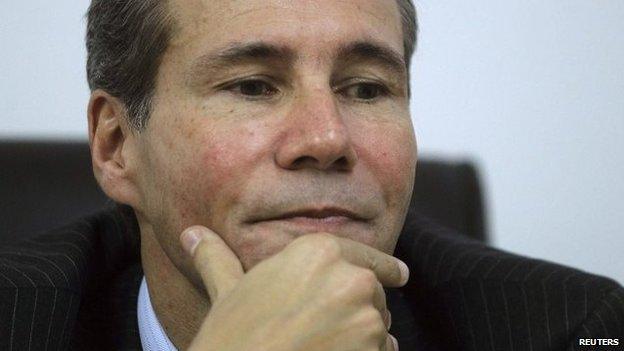
Alberto Nisman died of a gunshot wound on 18 January, just hours before he was due to give evidence
The death on 18 January of top Argentine prosecutor Alberto Nisman has led to fevered speculation in Argentina and abroad.
Conjecture about the cause of his death emerged almost immediately as Mr Nisman had been due to give details of controversial allegations against President Cristina Fernandez de Kirchner and other high-ranking officials.
He had accused them of involvement in a plot to cover up Iran's alleged role in the 1994 bombing of the Amia Jewish community centre in Buenos Aires.
President Fernandez herself has cast doubts on the theory put forward by an investigating prosecutor that his death was suicide.
Here we look at some of the background to the case and the theories that have been put forward.

What was Mr Nisman investigating?
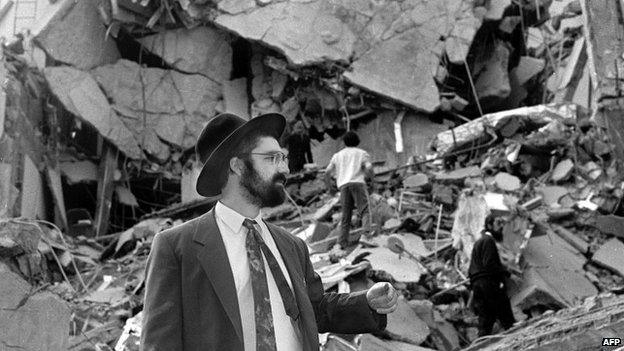
The bombing of the Amia Jewish centre in Buenos Aires left 85 dead
Alberto Nisman was investigating the 1994 bombing of a Jewish community centre in Buenos Aires, in which 85 people died.
He was put in charge of the probe in 2004 by the then-President Nestor Kirchner, Cristina Fernandez de Kirchner's late husband.
Mr Nisman was chosen to head the investigation after the previous investigation, led by judge Juan Jose Galeano, collapsed.

What is known about the 1994 bombing?
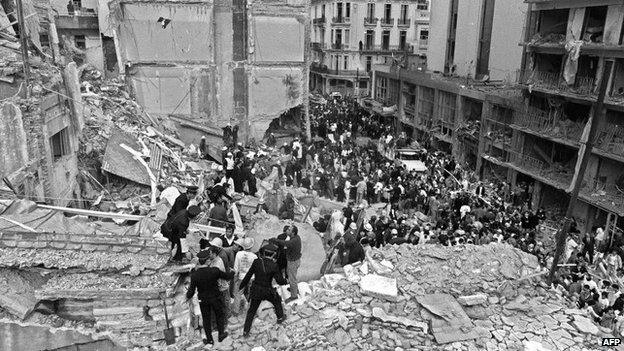
No-one has been convicted over the 1994 attack
A car bomb exploded outside the Argentine Israelite Mutual Association (Amia) on 18 July 1994.
The seven-storey building collapsed and 85 people were killed.
It was Argentina's deadliest terrorist attack.

Why was the Amia community centre targeted?
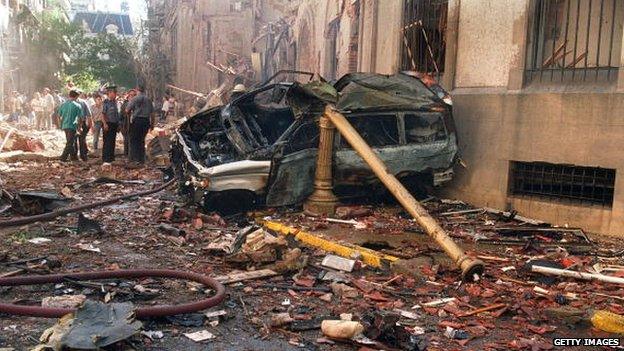
Two years before the Amia attack, the Israeli embassy in Buenos Aires was targeted
The attack on the Amia community centre came two years after 29 people died in an attack on the Israeli embassy in Buenos Aires.
A group calling itself Islamic Jihad Organisation said it was responsible for the 1992 attack.
The group alleged the bombing was in revenge for the killing by Israel of Hezbollah leader Abbas al-Mussawi that same year.
Jewish and Israeli institutions abroad were seen as "soft targets", easier to attack than similar buildings in Israel.
Theories therefore soon surfaced pointing the finger for the Amia bombing at Hezbollah, a mainly Shia group backed by Iran.
Iran has denied any involvement in either of the attacks.

Who was behind the Amia attack?
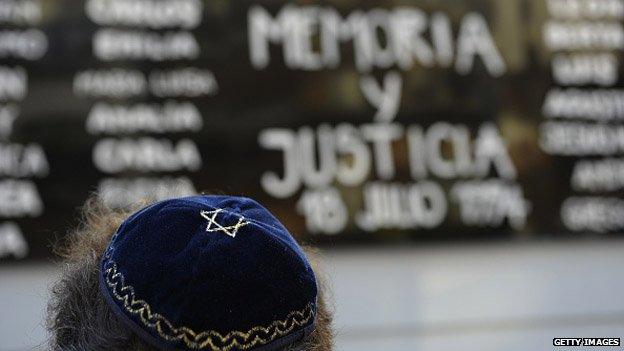
Relatives of the victims of the Amia bombing are demanding justice more than 20 years on
No one has been convicted in connection with the attack.
Twenty-two people were charged as part of the original investigation led by Judge Juan Jose Galeano.
After three years of hearings, the trial concluded in 2004 and all 22 suspects were found not guilty due to lack of evidence.

Who were the suspects?

The bombing, Argentina's worst terrorist attack, continues to be an open wound in Argentina society
From the beginning, investigators suspected Iranian officials may have been behind the bombing.
Also among the accused were members of the Buenos Aires police force, who were suspected of helping to carry out the attack.
Argentine car salesman Carlos Telledin was accused of selling the lorry used in the attack.
The investigation and the court case were overshadowed by allegations that Judge Galeano paid Mr Telledin $400,000 (£263,000) to inculpate the police officers.
Judge Galeano was impeached. He is facing trial later this year accused of covering up evidence in the case.

What did Mr Nisman uncover?

Mr Nisman made serious allegations against President Fernandez and other officials
In 2006, Mr Nisman formally charged Iranian officials with directing the Amia attack, which he alleged was carried out by Hezbollah militants.
In his most recent report, published just days before his death, he furthermore accused President Fernandez and Foreign Minister Hector Timerman of covering up the Iran's purported role in the bombing.
He alleged that the government wanted to whitewash Iran in order to secure lucrative trade deals with Iran, exchanging Argentine grain for Iranian oil.
President Fernandez dismissed the allegations as "absurd".

Why was Mr Nisman's death considered "suspicious"?
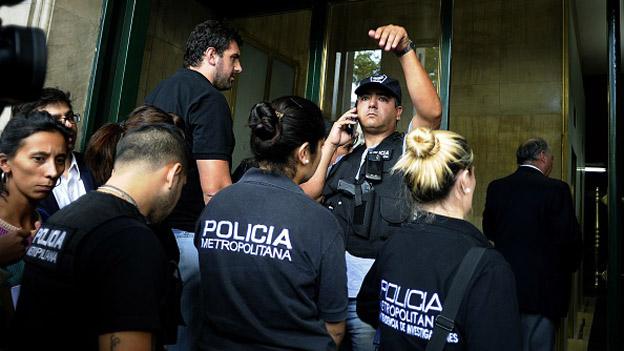
Police searched the office and apartment of Mr Nisman for evidence
Speaking on 19 January, a day after Mr Nisman's body was found, investigating prosecutor Viviana Fein told reporters that his death was "suspicious", but that there was no indication of an "outside link" or the involvement of anyone else in his death.
She did not rule out that Mr Nisman might have been "induced" to take his own life, though.
"We're going to investigate if there was any kind of instigation to suicide through threats, be they through phone calls or text messages," she said.
Ms Fein added that suicide was the most likely cause.
But the time of his death, just hours before he was due to give details of his allegations against President Fernandez to a congressional committee, triggered outraged comments on social media networks, with many questioning whether the prosecutor may have been murdered.

What theories have been put forward about his death?
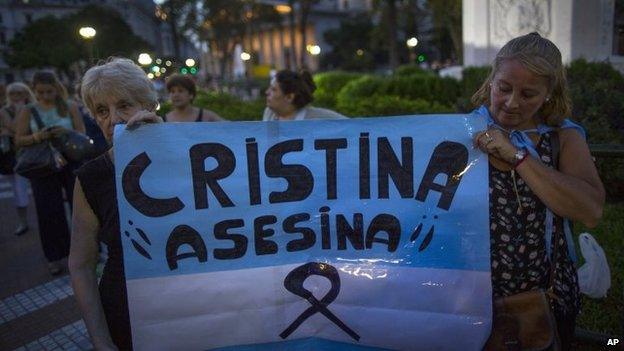
Some protesters have accused the President Fernandez of involvement in the death of Mr Nisman
Opposition member of parliament Elisa Carrio told daily Clarin, external [in Spanish] that she was convinced Mr Nisman had been murdered and that "the government, the power" had played a role in his death.
"They killed him," she said. "I thought they stole and systematically lied, but I never thought they would be capable of killing," she added.
Her views were mirrored by some of the protesters who demonstrated in front of the presidential palace in the days following Mr Nisman's death.
They yelled "murderer", and held up placards demanding justice for Mr Nisman.

What did President Fernandez say?
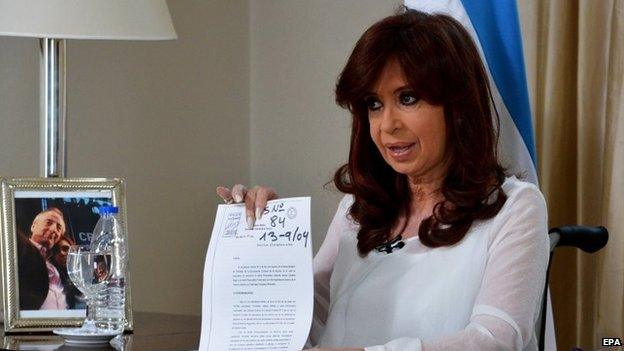
President Fernandez has claimed that Mr Nisman was manipulated
In a letter, external [in Spanish] published a day after Mr Nisman's body was found, the president referred to Mr Nisman's death as a "suicide". The word was followed by a question mark.
She also asked what could have led a person to take the terrible decision to take his life.
Two days later, in another letter published on her website, external [in Spanish], President Fernandez wrote: "I'm convinced that it was not suicide".
She alleged that Mr Nisman was manipulated to attack her and her government.
"They used him alive and then they needed him dead," she wrote.
She did not explain who she thought had killed him but added that his death was "sad and terrible".

What is the role of the spy agency?
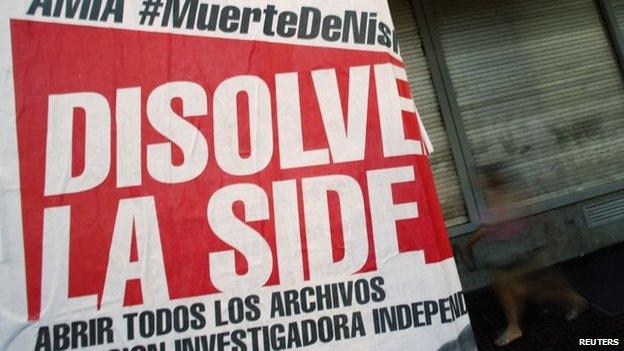
After Mr Nisman's death there have been calls for the dissolution of the SI intelligence agency
President Fernandez alleged Mr Nisman had been manipulated by rogue agents inside the Intelligence Secretariat (SI).
Parts of Mr Nisman's report were based on wiretaps and the president suggested he was fed false information by disgruntled spies and stooges posing as spies.
Ms Fernandez said she had "no proof" of her allegations, but stressed she had "no doubts" either.